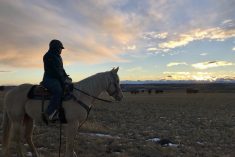Bale grazing is no different than any other production practice. You need to manage it and improve your skills to make it work. If the economics of bale grazing works for your operation, then it is a worthwhile skill to learn. But it is a skill and if you try it for the first time and you have a wreck, it does not mean that it won’t work. You just need some practice and maybe a few tips and tricks to make it work better. I’ve been making mistakes with bale grazing for more than 15 years now. The most common issue I hear with bale grazing is keeping the cattle’s respect for the electric fence in wintertime. Electric fence is not as effective in the winter due to the insulation of the snow and frozen ground. The shock is normally transferred through the animal to the moisture in the ground, but if the ground is frozen and covered by snow, the shock is reduced. Here are my tips to keeping the electric fence “hot” in winter. These would apply for swath grazing, bunch grazing or corn grazing as well.
Read Also

Reintroducing fire to Saskatchewan pastures
Pastures evolve over time. Woody plants and shrubs, which cattle can’t eat, may encroach on natural grasses. Invasive species, such…
WINTER FENCING RULES:
Number 1:Have the animals well trained in the fall. I put extra effort into making sure any animal I am going to be wintering really respects the fence. I use my best fencer and not a lot of fence. Hit em’ hard! I like to see over 10 KV in my fence in the fall. If I have to take out an extra fencer to run just the watering area, I will.
Number 2:Build an educational fence for the winter by the water. I try to construct a short fence right beside the winter watering site that is strong. There is going to be a bit of pushing and shoving near the water so they will be bumping into it every day. I try to use high tensile or barbed wire and build a two-wire fence. The top wire is hot and the bottom wire is grounded. For it to shock the animal, they have to touch both wires. It could be an alley-way or an existing watering area but it has to be close to the water. The grounded wire eliminates the need for the shock to go through the animal to the ground. Instead it goes from the hot wire through the animal to the ground wire that is connected to the ground rod. If my water source is a dugout, I push the ground rod through the water into the mud. If they are getting zapped by the educational fence, they will respect the cross fences out in the field. If you use snow as a water source, this might not work as well. Try to set this fence up somewhere that it is under a little pressure. Maybe place the salt block beside the educational fence. It saves the work of making all your cross fences two wires.
Number 3:Always set up your second cross fence right away. I never want to give the cattle a reason to put pressure on the electric fence. I use two temporary cross fences and leapfrog them down the paddock. This means that when I take the first fence down and allow the cattle into the next set of bales, the second fence is already up. ALWAYS set the next fence up right away while the cattle are content with all the new feed. This gives you a backup fence, just in case, and saves putting pressure on the temporary fence next time you move. If it is already set up and you come out to move cows, you can move them right away. No fence pressure.
The alternative is to spend 15 minutes setting up the next cross fence every time you come out to move the cows. For 15 minutes you then have a herd of hungry cows all pushing and shov- ing and looking over a weak little fence with very little shocking power! You’re asking for a wreck. Don’t give them a reason to crowd the cross fence.
Number 4:Never move in the dark. This just makes sense but I know I have been in that spot before, coming home late in the day and needing to move the fence. There are not a lot of daylight hours here in the wintertime but I try to move in the light. If I have to feed in the evening or early in the morning, I will roll out a bale or two in the open pasture first. This gives the cattle something to eat and distracts them while I move the fence. When they are done, they slowly wander back and phase into the new set of bales. They don’t rush in and blow through the cross fence because they don’t see it. To make the issue worse, at this point when the cattle blow through that second fence in the dark, the “back up” fence is in your hands! Kind of makes for a stressful evening.
Number 5:Never give them a reason to reach under the fence. I always make sure my cross fence is far enough away from the next set of bales or the next swaths that the
cattle are not tempted to reach under it. If you are using posts that stick into the bales, make sure they are long enough not to tempt the cattle. I suggest using eight-foot posts in the bales. I currently use a pigtail post in the ground but I make sure I stay at least five or six feet away from the next set of bales.
I have heard a lot of advice for swath grazing that says to run the cross fencing perpendicular to your swaths so the cattle can always find the swaths. Not for me! I run parallel with the swaths and make sure my fence never crosses a swath. You’re just asking them to test the fence the other way. I plan my end fence posts in the fall to make sure I can keep the cross fence between two swaths. Even through two feet of snow, they always find the swath just fine.
Feel free to take one or two of these ideas and adapt them to your operation. I don’t make mistakes on my ranch. I make “experiments” that don’t turn out the way I expected! My best wishes to you and your family with hopes that you can learn from my “experiments” as I have.
SteveKenyonrunsGreenerPasturesRanching
Ltd.inBusby,Alta., www.greenerpasturesranching.com,
(780)307-6500,
email [email protected].
———
Never move in the dark. This just makes sense but I know I have been in that spot before, coming home late in the day and needing to move the fence
















